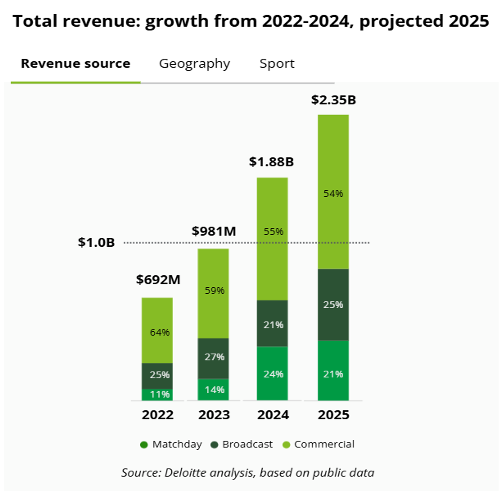Deloitte predicts global revenues in women’s sport to reach $2.35 billion in 2025, but the financial challenges to women’s football linger
For all figures used, credit given to Deloitte

Deloitte have reported on the growth of Women’s sport, and the projections are startling!
Women’s basketball is perceived to generate more than $1 billion of the amount shown in the photo above, leapfrogging women’s football in terms of its financial dominance in the sports industry.
This seems to echo the current perceptions of women’s football and the lack of funds within it:
- the average salary for players worldwide is $10,900.
- On average, year-on-year losses are being made at 67% of top clubs.
- Average operating expenses are 71.1% higher than average operating revenue across the teams in the 24 highest ranked territories.
- Only four leagues had title-sponsorship deals worth more than $1m a year!
Despite these issues, Deloitte demonstrate that there is clearly a continued investment in women’s sport in general, highlighting the huge commercial opportunities and global fanbase that stars like Mary Earps, Sam Kerr and even Alisha Lehmann (who has 17 million followers on Instagram) can bring.
The hope is that women’s football will resume its position back at the top due to the nature of the assets owned – the individual star-power within the NBA now, alongside their commercial deals and merchandising, should not be able to compete with the longevity of football and its subsisting relevance. The question is, how can this happen?
Only 22% of head coach roles are filled by women on an international level. In a men’s model, ex-players become coaches. For the coaches that weren’t good footballers, there were clear and consistent pathways for them to be nurtured and develop from a grassroots level. The more quality coaches, the more quality football played and players. The more quality football, the more engagement, revenue and fans.
Huge strides have been made in the last year towards women’s sport in general as Deloitte point out:
- The Olympic Games Paris 2024 was the first Olympic Games with an equal representation for both male and female athletes
- WNBA secured a new broadcast deal
- Zheng Qinwen, the first Asian tennis player to win an Olympic gold in singles, became the latest Dior ambassador
But I revert to the question of how can we ensure that women’s football gets back to the top?
If you look at emerging markets like Japan and Australia, they have made great progress and have benefitted from the global appeal and longevity that football has. Across the Middle East, resources are directed towards grassroots initiatives designed to encourage women to participate in sports. Australia have invested in stadium infrastructure, enhanced training facilities, and affected legacy programs to promote long-term growth. Investment in Japan has already bore the fruit that it needed to in generating revenue – their clubs Sanfrecce Hiroshima Regina and Omiya Ardija Ventus reported revenues just outside the top 15 in the whole world for women’s clubs in 2025.
There are still several hurdles to stunt the upward curve for women’s sport. This is why investment is crucial. In the infrastructure, player participation, building role models for the future generations and showcasing that there is a journey for athletes to reach their full potential.